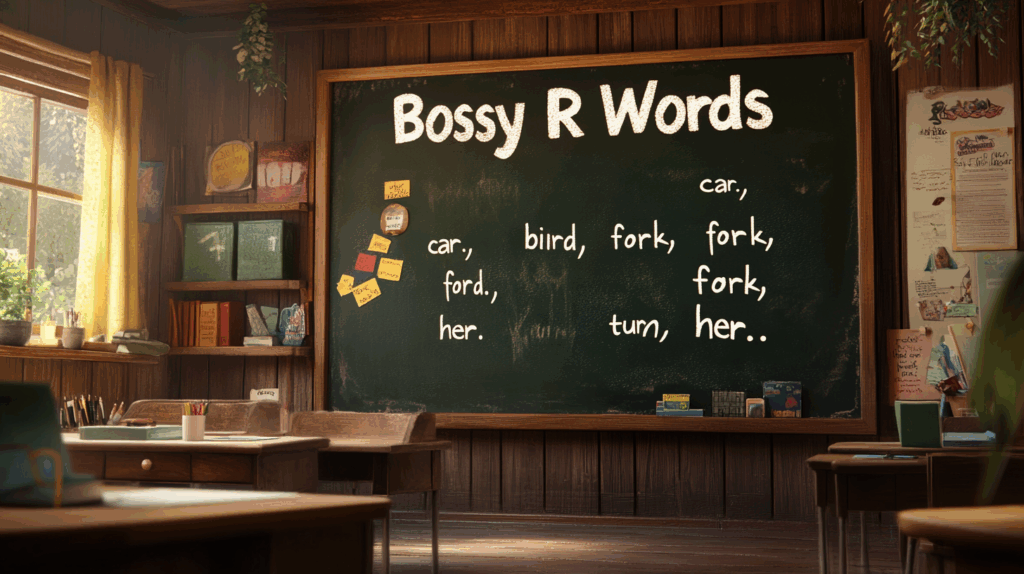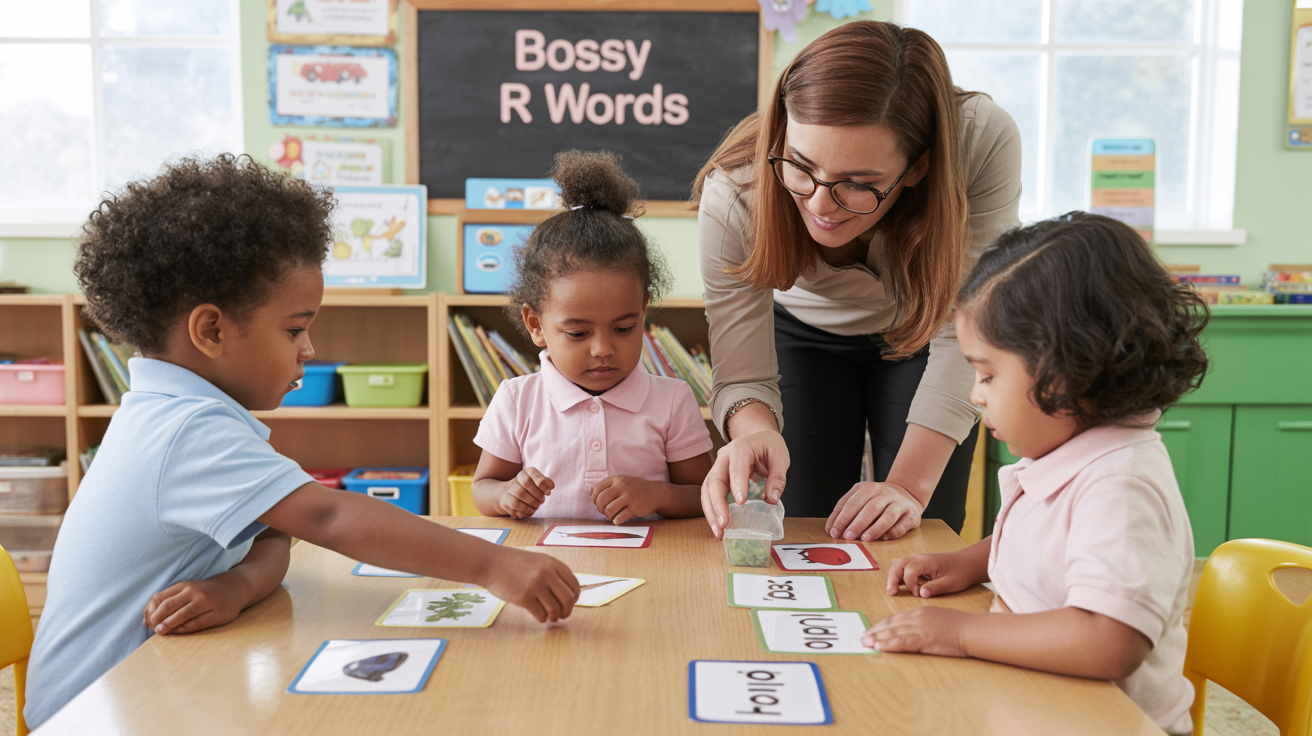Teaching kids to read can be tough. Parents and teachers often feel stuck when their children struggle with tricky vowel sounds.
The letters ‘ar’, ‘er’, ‘ir’, ‘or’, and ‘ur’ create a special challenge in early reading. When the letter ‘r’ follows a vowel, it changes how that vowel sounds, that’s why we call it “Bossy R.”
But you don’t need fancy methods or complex tools to teach these sounds! With a few simple, fun methods, kids can learn these rules quickly and keep them in their memory for good.
This blog will show you exactly how to teach bossy R rules in ways that work well and last long. Let’s look at some plain, useful tips that will make teaching R-Controlled syllables much less stressful.
What Are Bossy R Rules?

Bossy R Rules focus on a special group of sounds in reading. When the letter ‘r’ comes right after a vowel, it changes how that vowel sounds.
This is why we call the ‘r’ “bossy” – it tells the vowel what to do. The vowel is no longer short (like in “cat”) or long (like in “cake”). Instead, the vowel and ‘r’ team up to make a new sound.
You’ll find these sounds in many common words. Think about how you say “car” – the ‘a doesn’t sound like in “cat” or “cake.” The same thing happens in words like “fork,” “bird,” “her,” “turn,” and “star.” Each vowel gets a new job when ‘r’ is its partner.
For young readers, these patterns can be hard to spot at first. But once they learn this rule, they’ll have an easier time with many new words they find in books.
Why is the Bossy R Rule Important?
The Bossy R Rules play a key role in helping children build strong reading skills. When children master these sounds early, they gain confidence in both reading and writing. This rule matters for several reasons:
- Better word recognition: When children know how ‘r’ affects vowels, they can sound out many more words correctly and quickly.
- Improved reading flow: Kids who understand these rules read with fewer stops and starts, making their reading smoother.
- Stronger spelling: Many spelling errors happen when children mix up vowel sounds. Knowing these rules helps them spell words like “bird” or “turn” correctly.
- Clear speaking: The Bossy R sounds are common in everyday talk. Learning them helps children speak more clearly.
- Building block for later skills: This rule helps children tackle longer, more complex words as they grow. It forms a base for reading bigger words with multiple parts.
Common Bossy R Vowel Sounds
Learning the main Bossy R patterns helps children read many common words. These sounds show up often in books for young readers. Let’s look at each pattern with simple examples.
The five Bossy R vowel sounds change how we say words in important ways. While they follow patterns, some sounds like ‘er’, ‘ir’, and ‘ur’ often sound very similar.
Here’s how each one works:
‘Ar’ Word Examples
- Car
- Star
- Farm
- Park
- Yard
‘Or’ Word Examples
- Fork
- Corn
- Sort
- Storm
- Port
‘ER’ Word Examples
- Her
- Term
- Serve
- Fern
- Person
‘Ir’ Word Examples
- Bird
- Girl
- First
- Shirt
- Third
‘Ur’ Word Examples
- Turn
- Burn
- Surf
- Hurt
- Curl
When Bossy R appears in parts of words that aren’t stressed, it can make a softer sound. For example, in words like “sister” or “doctor,” the final “-er” has a lighter sound than in “her” or “term.”
R-Controlled Syllable Spelling Rules
When we spell words with Bossy R, we need to follow a few key rules that help us get the words right on paper. These spelling guides make it easier to know which letters to use.
Rule #1: When a vowel sits next to the letter “r,” the “r” changes how the vowel sounds. The vowel is no longer short or long but makes a new sound with the “r.” For example, the “a” in “car” doesn’t sound like the “a” in “cat” or “cake.”
Rule #2: The letter teams “er,” “ir,” and “ur” often sound the same in words. They all make a sound like the “ur” in “nurse.” This is why words like “her,” “bird,” and “turn” have the same vowel sound, even with different letters.
Rule #3: Most r-controlled words don’t need a silent “e” at the end. The “r” itself changes the vowel sound, so no extra “e” is required.
Simple & Effective Methods to Teach R-Controlled Syllables

Teaching Bossy R sounds doesn’t have to be hard. Here are four simple methods that work well and keep kids interested. Try these in your classroom or at home.
Begin with the Most Clear Sounds
Start with “ar” and “or” sounds since they’re the easiest to hear and say. Show pictures of cars, stars, forks, and corn. Have children say these words out loud and feel how their mouth moves.
Make word cards with pictures and use them for quick daily practice. Keep coming back to these sounds until kids know them well.
Sort Words by Sound
Make small cards with r-controlled words. Ask children to sort them by sound pattern – put all “ar” words in one pile, “or” words in another, and so on.
This helps them see the patterns and hear the differences. You can start with just two sounds and add more as kids get better at it.
Create a Bossy R Character
Make up a story about “Bossy R,” who likes to change how vowels sound. Draw a cartoon character of Bossy R with a crown or cape.
When you show a word like “car,” talk about how Bossy R changes the “a” sound. Kids love stories and will remember the rule better this way.
Use Hands-On Activities
Make learning physical. Have kids stand up when they hear an “ar” word and sit down for an “or” word. Use clay or blocks to build words.
Try music with songs about Bossy R. Make a chart where kids can add new Bossy R words they find in books. These active methods help the learning stick better.
Teaching R-Controlled Vowels: Fun Activities
Here are fun ways to teach the Bossy R rules that kids will enjoy.
- Word Sorts: Sort picture cards or word cards into groups based on their Bossy R sound. Mix real words like “car” and “star” with made-up words like “zar” to test true understanding.
- Sound Detective: Give kids a stack of picture cards. They hold up a “yes” or “no” card to show if they hear a Bossy R sound in each word. This quick game sharpens listening skills.
- Bossy R Bingo: Create bingo cards with R-controlled words. Call out the words or show pictures, and have kids cover the matching words on their cards.
- Spin & Read Wheels: Make a wheel with r-controlled words. Kids spin the wheel and read the word it lands on. If they read it right, they get a point.
- Bossy R Crowns: Let kids make paper crowns with the “Bossy R” letter on top. They wear these while practicing r-controlled words to remember how bossy the “r” is.
- Mini-Books: Help kids create small books with one r-controlled sound per page. They can draw pictures and write simple words for each sound.
Wrapping It Up
Teaching Bossy R rules helps kids become better readers and writers. These tricky vowel-plus-r teams show up in many common words, and knowing them builds reading confidence.
The best way to help children learn is to mix fun with practice. Remember that every child learns at their own pace. Some may pick up these sounds quickly, while others need more time.
By using these simple methods and keeping practice regular, you’ll help children master these important sounds and grow as readers.
What’s your experience? Have you found a method that works well for teaching Bossy R sounds? Share your tips in the comments below!




